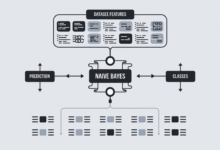
Understanding Bias in Deep Learning
Bias in deep learning can arise from various sources and manifest in different forms, each affecting machine learning fairness:
- Sampling Bias: When training data doesn't accurately represent the real-world population, leading to skewed results.
- Algorithmic Bias: Emerging from the algorithms themselves, often due to unintentional preferences or skewed training data.
- Measurement Bias: Arising from how users choose, employ, and measure particular features.
- Representation Bias: When data doesn't reflect all demographics.
- Aggregation Bias: Obscuring specific needs within groups.
- Linking Bias: Introducing errors by incorporating irrelevant data.
- Omitted Variable Bias: Missing crucial variables leading to unfair outcomes.
A striking example of measurement bias was observed in the Correctional Offender Management Profiling for Alternative Sanctions tool used in US courts. It considered 'prior arrests' and 'family or friend arrests' as proxies for 'riskiness', potentially disadvantaging minority communities due to higher surveillance rates.
Addressing these biases is crucial for creating fair and ethical AI systems. Researchers are developing techniques to detect and mitigate bias, such as carefully curating training data, regularly auditing algorithms, and involving diverse teams in development and evaluation processes.

Evaluating Model Fairness
Evaluating fairness in machine learning models is a complex task that requires careful consideration of multiple factors. Several key principles and metrics are used to assess and ensure fairness:
Key Principles of Machine Learning Ethics
- Fairness: Ensuring algorithms don't discriminate against individuals or groups based on protected characteristics.
- Transparency: Providing clear explanations of how algorithms make decisions to foster accountability and trust.
- Privacy: Safeguarding individuals' personal information and ensuring it's not misused.
- Accountability: Holding developers and users of ML systems responsible for their actions and outcomes.
Fairness Metrics
Several metrics are used to evaluate fairness in machine learning models:
- Demographic Parity: Requires that algorithm outcomes are independent of protected attributes.
- Equalized Odds: Requires equal true positive and false positive rates across demographic groups.
- Equality of Opportunity: Specifies equal true positive rates across groups.
- Predictive Parity: Requires equal positive predictive value across demographic groups.
- Calibration: Ensures predicted probabilities of positive outcomes are accurate for each group.
It's important to note that these fairness criteria often involve trade-offs, as optimizing for one may negatively impact another. The choice of appropriate fairness metric depends on the specific context, domain, and societal values at stake.
Evaluating fairness also requires ongoing research, collaboration, and continuous refinement of algorithms. Techniques such as counterfactual fairness, which involves simulating alternative scenarios, can provide insights into potential biases and guide corrective measures.
Mitigating Bias in Deep Learning
Mitigating bias in deep learning requires a multi-faceted approach that addresses various stages of the machine learning lifecycle. Here are some key strategies:
Pre-processing Methods
- Data Augmentation: Enhance dataset diversity to reduce representation bias.
- Synthetic Data Generation: Create artificial data points to fill gaps in underrepresented groups.
- Feature Selection and Engineering: Carefully choose or modify features to minimize bias.
In-processing Techniques
- Fairness-aware Algorithms: Incorporate fairness constraints directly into the learning process.
- Adversarial Debiasing: Use adversarial techniques to remove sensitive information from representations.
- Regularization: Apply fairness-specific regularization terms to the objective function.
Post-processing Approaches
- Threshold Adjustment: Modify decision thresholds to achieve fairness across groups.
- Calibration: Adjust model outputs to ensure equal predictive value across groups.
- Ensemble Methods: Combine multiple models to balance out individual biases.
It's crucial to employ a combination of these techniques and continually monitor and evaluate the model's performance and fairness metrics. Regular audits and updates are essential to ensure sustained fairness as new data and scenarios emerge.
Furthermore, involving diverse teams in the development and evaluation processes can help identify and address potential biases that might be overlooked. Collaboration between data scientists, ethicists, domain experts, and representatives from potentially affected communities is vital for comprehensive bias mitigation.
Transparency and Accountability in AI
Ensuring transparency and accountability in AI systems is crucial for building trust and enabling effective oversight. Here are key aspects to consider:
Explainability and Interpretability
Explainable AI (XAI) techniques aim to make black-box models more transparent:
- LIME (Local Interpretable Model-agnostic Explanations): Explains individual predictions by approximating the model locally.
- SHAP (SHapley Additive exPlanations): Uses game theory concepts to attribute feature importance.
- Attention Mechanisms: In neural networks, highlight which parts of the input are most influential for a decision.
Regulatory Frameworks
Emerging regulations are shaping the landscape of AI accountability:
- GDPR: Requires explanations for automated decisions affecting individuals in the EU.
- AI Act (proposed): The EU's comprehensive attempt to regulate AI systems based on risk levels.
- Local Initiatives: Such as New York City's AI bias law, focusing on fairness in automated employment decisions.
Auditing and Documentation
Regular audits and comprehensive documentation are essential:
- Implement robust logging mechanisms to track model decisions and updates.
- Conduct regular fairness and bias assessments, especially after model updates or when applied to new populations.
- Maintain detailed records of data sources, preprocessing steps, and model architectures.
Transparency and accountability in AI require ongoing effort and collaboration between technologists, policymakers, and ethicists. By prioritizing these principles, we can work towards AI systems that are not only powerful but also trustworthy and aligned with societal values.
Real-World Applications and Case Studies
Examining real-world applications of AI systems provides valuable insights into the challenges and successes in addressing bias and fairness. Here are some notable case studies:
Healthcare
AI in healthcare has shown promise but also revealed concerning biases:
- Skin Cancer Detection: Initial AI models showed lower accuracy for darker skin tones due to underrepresentation in training data. Efforts to diversify datasets have improved performance across skin types.
- Clinical Decision Support: Some systems have shown biases in pain assessment and treatment recommendations based on race and gender. Ongoing work focuses on developing more equitable algorithms.
Criminal Justice
The use of AI in criminal justice has been particularly controversial:
- Recidivism Prediction: Tools like COMPAS have been criticized for racial bias in predicting reoffense rates. This has sparked debates about the use of such tools in sentencing decisions.
- Facial Recognition: Studies have shown higher error rates for women and people of color, leading some jurisdictions to ban or limit its use in law enforcement.
Employment
AI in hiring and recruitment has faced scrutiny for perpetuating biases:
- Resume Screening: Some AI tools have shown gender and racial biases in candidate selection. Companies are now focusing on developing more equitable screening algorithms.
- Video Interview Analysis: Concerns about facial and voice analysis discriminating against certain groups have led to increased regulation and calls for transparency.
Financial Services
The finance sector has seen both challenges and progress in AI fairness:
- Credit Scoring: Traditional models have been criticized for perpetuating historical biases. New approaches aim to use alternative data sources and fairness-aware algorithms to improve equity in lending.
- Fraud Detection: Some systems have shown higher false positive rates for minority groups. Ongoing research focuses on developing more balanced detection models.
These case studies highlight the complex challenges in developing fair AI systems. They underscore the importance of diverse datasets, rigorous testing across different demographic groups, and ongoing monitoring and adjustment of deployed systems. As AI continues to impact critical decisions in various sectors, ensuring fairness and mitigating bias remains a crucial and evolving challenge.
Addressing biases in AI is essential for the ethics and functionality of these systems. By focusing on fairness, transparency, and accountability, we can build AI that serves all segments of society equitably. As the field evolves, continued research, collaboration, and vigilance will be crucial in creating AI systems that are not only powerful but also just and inclusive.
Revolutionize your website with Writio, the AI content writer. This article was crafted by Writio.
- Chouldechova A. Fair prediction with disparate impact: A study of bias in recidivism prediction instruments. Big Data. 2017;5(2):153-163.
- D'Amour A, Srinivasan H, Atwood J, et al. Fairness is not static: deeper understanding of long term fairness via simulation studies. Proceedings of the 2020 Conference on Fairness, Accountability, and Transparency. 2020:525-534.
- Mehrabi N, Morstatter F, Saxena N, Lerman K, Galstyan A. A survey on bias and fairness in machine learning. ACM Comput Surv. 2021;54(6):1-35.
- Zhang BH, Lemoine B, Mitchell M. Mitigating unwanted biases with adversarial learning. Proceedings of the 2018 AAAI/ACM Conference on AI, Ethics, and Society. 2018:335-340.
- Zemel R, Wu Y, Swersky K, Pitassi T, Dwork C. Learning fair representations. Proceedings of the 30th International Conference on Machine Learning. 2013:325-333.







